If you’re after a lens with a focal range wide enough to cover most day-to-day situations, then your best bet is superzoom. Here are our pick of the five best superzoom lenses
The all-in-one ‘superzoom’ tends to get a bad press. Conventional wisdom states that zooms with a more limited 4x range can be very good, but extend that to 10x or more and the technical and engineering compromises become too big to overcome and image quality suffers. Because of this many photographers prefer to carry two zooms to cover 18-200mm – typically an 18-55mm kit lens and a 55-200mm telephoto. A superzoom has advantages over carrying multiple lenses though, as they allow you to cover a huge focal range without having to change lenses. This makes them especially useful if changing lenses every five minutes is impractical, or if you’re travelling and want to keep your kit to a minimum. Here are five of the best examples.
Key points of a Superzoom Lens
Extra-Low Dispersion and Aspherical Elements
Superzoom lenses often display distortion at the wide and tele extremes and chromatic aberrations (fringing) on high contrast borders. While the use of extra-low dispersion (ED) and aspherical elements cannot wholly eliminate the problem, they do go a long way towards improving overall image quality.
Image Stabilisation
Most superzooms have built-in IS. As most superzooms offer a maximum aperture of just f/6.3 at 200mm, having a few stops of shutter speed compensation to hand is useful when shooting in less than optimal light.
Zoom Lock
Because of the fact that 11x superzoom lenses provide such a wide focal range, they can sometimes suffer from lens creep issues – which is where the lens is prone to collapsing or extending under its own weight when it is held vertically when shooting at certain focal lengths. Manufacturers are doing their best to eliminate the problem, often by including zoom locks on these long lenses. While zoom locks do not solve the problem on their own, they nevertheless do allow you to lock the lens at its smallest size (usually 18mm) to allow for easier and more secure transportation.
1. Sigma 18-200mm f/3.5-6.3 DC Macro OS HSM
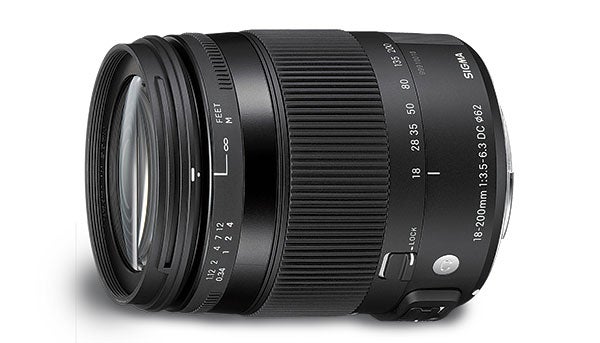
– Price: £249
– Construction: 16 elements / 13 groups
– Minimum focus distance: 39mm
– Built-in image stabilisation: Yes (Nikon/Canon); No (Sony/Pentax)
– Filter size: 62mm
– Dimensions: 86 x 70.7mm
– Weight: 430g
Sigma’s newest version of its 18-200mm lens offers an outstanding image quality performance – and is the best superzoom currently out there.
Third-party lens specialist Sigma has offered a 18-200mm superzoom to fit all of the major DSLR brands for just over a decade now. In fact, Sigma’s original 18-200mm f/3.5-6.3 DC lens was the first 11x superzoom of its kind to be designed specifically for APS-C equipped DSLRs. Released in 2014, this latest incarnation follows on from the 2007 and 2011 refreshes that introduced Sigma’s Optical Stabilisation and Hypersonic Motor technology to the 2005 edition. Significantly smaller and lighter than all previous Sigma 18-200mm superzooms, the latest release also introduces basic Macro shooting at a maximum magnification of 1:3 at a minimum shooting distance of 39cm. It’s the best 18-200mm superzoom Sigma has yet produced. In fact, we’d say it’s the best 18-200mm superzoom currently on the market.
Designed for DSLRs equipped with APS-C sized sensors and available for Nikon, Canon, Sony and Pentax lens mounts, the Sigma 18-200mm is constructed from 16 elements in 13 groups. This includes four Special Low Dispersion (SLD) glass elements to reduce purple fringing and three aspherical lens elements to control barrel distortion at wideangle settings and pincushion distortion at extended telephoto settings. The lens also has Sigma’s Super Multi-Layer Coating to reduce flare and ghosting. A petal- shaped lens hood is also supplied, which can be mounted to the front of the lens for added protection against flare. In terms of image stabilisation, it is offered in two slightly different guises: for Nikon and Canon owners the lens comes with Sigma’s proprietary Optical Stabilisation (OS) technology, which offers about three stops of shutter speed compensation.

Given that Sony and Pentax build image stabilisation technology directly into their camera bodies, this OS technology is removed on Sony- and Pentax-fit lenses. Focusing is powered by the built-in Hypersonic Motor (HSM), which proves to be both speedy and near silent in operation.
Overall build quality impresses too, with the lens barrels constructed from tough plastic that feels durable enough to stand up to regular use and transportation inside a camera bag. The zoom and manual focus rings are both finished with rubberised rings, which help to ensure a decent grip. As you’d expect, the lens mount is fashioned from metal. One of the most impressive things about the lens is how Sigma has managed to reduce its overall size (and weight) compared to previous incarnations. Whereas the 2007 edition measured 98 x 79mm, the 2014 edition is just 86 x 70.7mm. One effect of this reduction in size isthat the lens has a 62mm filter thread (rather than the 72mm one found in the 2007 edition). Ultimately this could save you a fair bit of money on filters. Focusing is handled internally too, so the front element does not rotate while the autofocus is engaged.
Available for around £250 the Sigma 18-200mm is much cheaper than its equivalents from Canon and Nikon, making it superb value. Image quality impresses too, with the centre of the frame being exceptionally sharp at 18mm and very good at the edges. At 50mm sharpness does decline a little, but remains excellent in the centre of the frame. At 200mm there is distinct loss of sharpness around the edges of the frame, however in the centre it’s still very good. Edge sharpness at extended telephoto settings can be improved by stopping down to around f/8-f/11 though.
Score: 4.5 out of 5

2. Nikon AF-S DX 18-200mm f/3.5-5.6G ED VR II
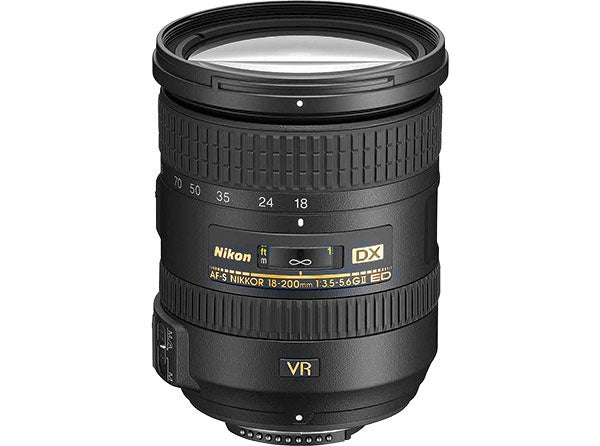
– Price: 549
– Construction: 16 elements / 12 groups
– Minimum focus distance: 50cm
– Built-in image stabilisation: Yes
– Filter size: 72mm
– Dimensions: 96.5 x 77mm
– Weight: 565g
Released in 2009, the Nikon 18-200mm VR II replaces the Nikon 18-200mm VR that came out in 2005. While the older model was a highly flexible and popular zoom, it was prone to lens creep and without a rubber O-ring (or Blu-Tack) to hand this could make hard work of shooting directly overhead, or up to the sky as the lens barrel was prone to moving under its own weight. Nikon claims that the newer 18-200mm VR II has a reworked zoom mechanism that addresses the issue, however online there are reports of lens creep still being an issue with owners of the newer lens. Either way, Nikon has added a zoom lock switch that locks the lens at 18mm to make it easier to carry. In most other respects, the newer lens is almost identical to the older one.
Designed for Nikon DSLRs equipped with APS-C sensors – ‘DX’ format cameras – the lens provides the 35mm equivalent of 24-300mm. Mounting it on a full-frame Nikon DSLR results in extreme vignetting and isn’t recommended. Internally, the lens has 16 elements in 12 groups, including two extra-low dispersion (ED) glass and three aspherical elements to ensure high resolution and superior contrast. It also has Nikon’s Vibration Reduction (VR) image stabilisation technology, which Nikon claims is good for up to four extra stops of shutter speed.

Focusing is taken care of internally so the filter thread does not rotate during use, making polarisers and ND grads easier to work with. A lens hood and a padded carry pouch are supplied. The outer lens barrels of the zoom are made from tough plastic, with the zoom and manual focus rings having a ridged rubber finish for improved grip.
While the lens creep issue doesn’t appear to have been fully resolved, the Nikon 18-200mm VR II remains an impressively flexible lens that offers reasonably good image quality for a superzoom. Between 18-70mm it is sharpest in the centre of the frame, but remains good at the edges and corners too, though at more extreme telephoto lengths corner and edge sharpness does noticeably fall off. Distortion is also quite pronounced, though relatively easy to fix at the post-processing stage.
Score: 4.5 out of 5

3. Canon EF-S 18-200mm f/3.5-5.6 IS
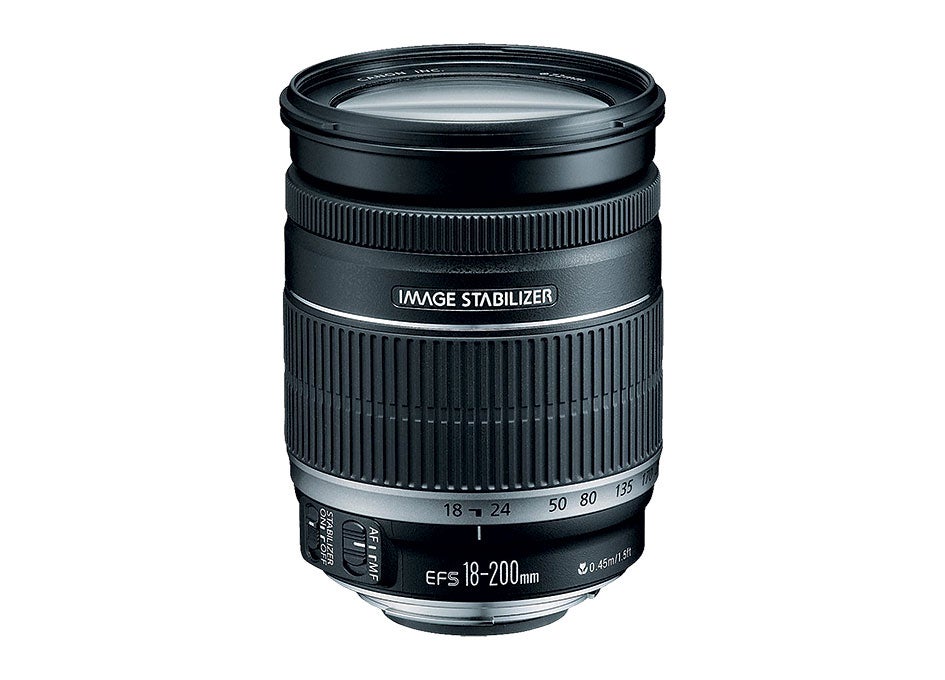
– Price: £356
– Construction: 16 elements / 12 groups
– Minimum focus distance: 45cm
– Built in image stabilisation: Yes
– Filter size: 72mm
– Dimensions: 102 x 76.8mm
– Weight: 595g
Released in 2008 the Canon 18-200mm (the 35mm equivalent of 29-320mm) is specifically designed for use with Canon APS-C DSLRs. As an EF-S lens it cannot be mounted on Canon full-frame DSLR bodies. It’s designed to appeal to entry-level and enthusiast-grade photographers looking for an optically stabilised lens with a large focal range. As such, it’s likely to appeal to Canon owners looking to advance their lens collection beyond the typical 18-55mm kit lens that most entry-level and mid-range DSLRs come with.
Internally the lens has 16 elements in 12 groups, which includes two aspheric elements designed to minimise the effects of distortion and two ultra-low dispersion (UD) elements to combat purple fringing and other chromatic aberrations. This is further complemented by Canon’s own Super-Spectra coating to reduce ghosting and flare.The lens also has Canon’s built-in Image Stabilisation technology, which provides up to four extra stops of shutter speed for sharper images at slower shutter speeds and extended telephoto settings. This is engaged via a switch on the side of the lens. Focusing is handled via an internal ultrasonic motor, which means the front element does not rotate during focus acquisition. It’s not possible to use the manual focus ring when the zoom is in AF mode though, so you’ll need to switch to MF mode if you want to use the MF ring.

Build quality is on a par with similar rivals, and while the outer lens barrels are constructed from tough plastic the lens mount is metal. In the hand it feels solid and robust enough to stand up to regular use. Some users have reported zoom creep issues, however. Image quality at short to medium focal-lengths reveals excellent levels of sharpness, however at 200mm the lens is much softer. Despite the use of UD elements chromatic aberration does exist, especially at 200mm.
This lens is well built, handles well and offers good – if not quite spectacular – image quality, though the issues that beset the Canon 18-200mm are found in virtually all lenses of this type. If you own a Canon APS-C DSLR, this lens is undoubtedly a useful addition.
Score: 4 out of 5

4. Tamron 18-200mm f/3.5-6.3 Di II VC
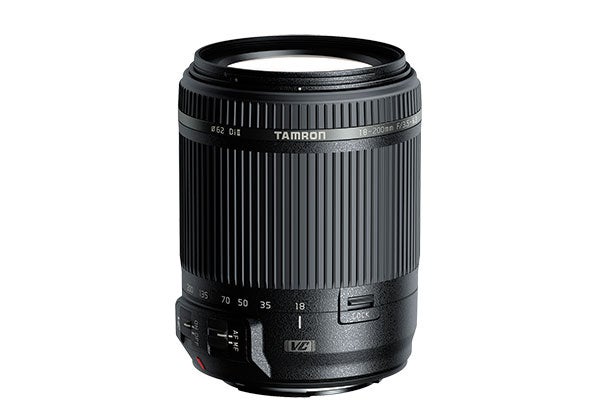
– Price: £169
– Construction: 16 elements / 14 groups
– Minimum focus distance: 50cm
– Built-in image stabilisation: Yes
– Filter size: 62mm
– Dimenions: 97 x 75mm
– Weight: 400g
Tamron’s latest superzoom enhances the company’s reputation for producing decent lenses on a budget. The Tamron 18-200mm is constructed from 16 elements in 14 groups, which includes one hybrid aspherical element and one low-dispersion glass element to reduce distortion and chromatic aberration. Most rival superzooms contain more in the way of special elements, which goes some way towards explaining the impressively low cost of this lens. That said, it does feature Tamron’s Vibration Compensation (VC) optical stabilisation technology. Focusing is internal, which means the filter thread will not rotate while the lens acquires focus. The zoom comes with a petal shaped hood to help reduce flare when shooting towards bright light sources.

The Tamron 18-200mm is predominantly constructed from plastic, with rubberised grips on the zoom and focus rings. The lens mount is also made from plastic, but with a metal sleeve on the inside that’s presumably designed to minimise wear. A rubber seal is positioned around the lens mount, however Tamron describes the lens as ‘splash resistant’ rather than fully waterproofed – use it in driving rain at your peril. In terms of handling, the zoom ring offers quite a bit of resistance and thankfully isn’t susceptible to lens creep either. Focusing is taken care of via Tamron’s DC motor-based system and is quiet and accurate, though not particularly fast. The lens is at its sharpest when used at wideangle settings, especially in the centre of the frame, but gets progressively softer as the zoom is extended, with a loss of really fine detail. Stopping down to f/8 gives the best results, but distortion is harder to control and you may need to employ a post-processing fix.
Despite being the cheapest superzoom of its kind, the Tamron’s overall image quality remains on a par with many similarly priced rivals. If you really want to get the best out of it then you’re better off shooting in Raw and applying the necessary post-processing fixes. For a highly flexible superzoom lens on a budget, however, there’s plenty to like.
Score: 4 out of 5

5. Pentax 18-270mm f/3.5-6.3 SMC DA SDM
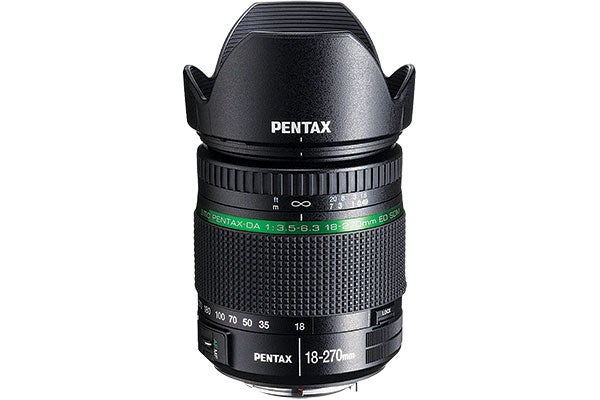
– Price: 415
– Construction: 16 elements / 13 groups
– Minimum focus distance: 49cm
– Built-in image stabilisation: No
– Filter size: 62mm
– Dimensions: 89 x 75.8mm
– Weight: 453g
Released towards the end of 2012, the big attraction with the Pentax 18-270mm is the additional telephoto reach it offers over many standard 18-200mm superzoom lenses. At the time of its release Pentax didn’t actually make a full-frame DSLR, so it comes as no great surprise that the 18-270mm zoom is designed for use with APS-C sensors, such as the Pentax K3 II, K-S2 and K-3 DSLR models. That said, it can also used with the all-new full-frame Pentax K-1 in crop mode. Thanks to the 1.5x crop quite slow at the telephoto end.

The Pentax 18-270mm is constructed from 16 elements in 13 groups. This includes two extra-low dispersion (ED) elements to minimise chromatic aberrations. The lens employs Pentax’s SDM autofocus technology that is driven by a built-in supersonic motor for quiet, speedy focus acquisition. It also benefits from internal focusing, which means the outer lens barrel does not rotate, allowing you to attach an ND Grad or Polariser filter to the 62mm filter thread without having to readjust after locking focus. Since Pentax builds its proprietary Shake Reduction image stabilisation technology directly into its DSLR bodies, the lens itself does not offer any IS technology.
The outer lens barrel is constructed from tough polycarbonate, topped off with a metal lens mount. Unlike many other recent Pentax lenses the 18-270mm is not waterproofed, though, which is a bit of a surprise given how dust and moisture resistance is such an integral selling point of most Pentax DSLRs.
The Pentax 18-270mm offers plenty of flexibility for the money. It’s also relatively light, and feels well balanced when attached to one of Pentax’s mid-level DSLRs. It’s just a shame that the lens doesn’t get the same protection against water and dust that many of its DSLRs enjoy.
Score: 4 out of 5





